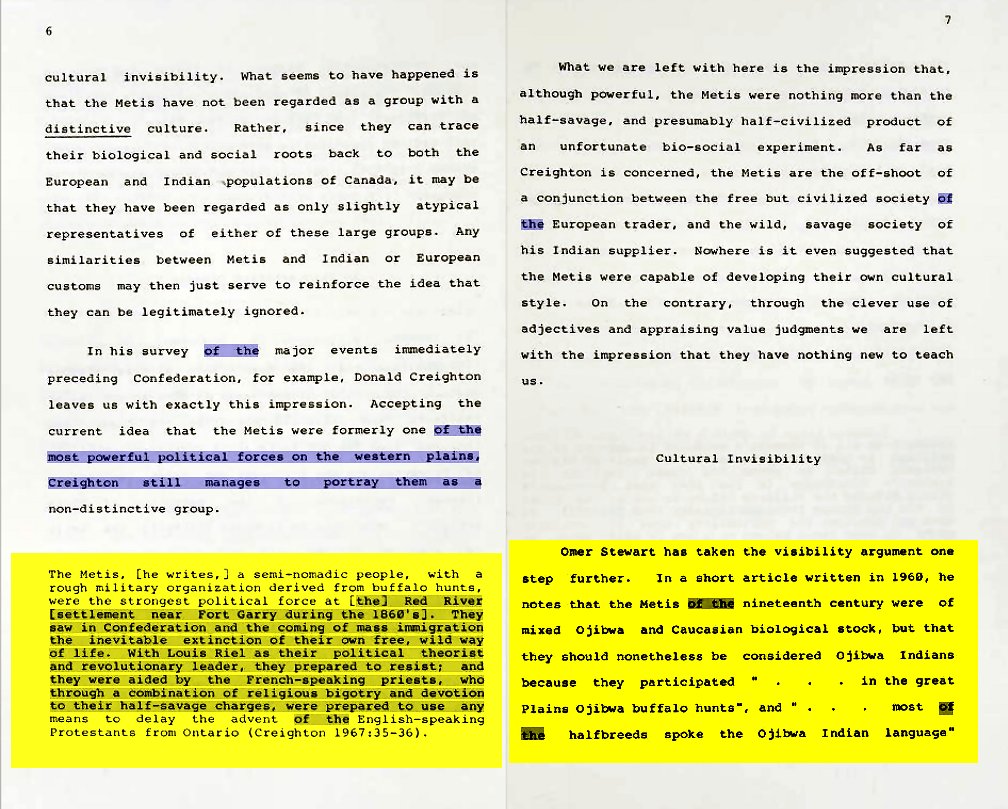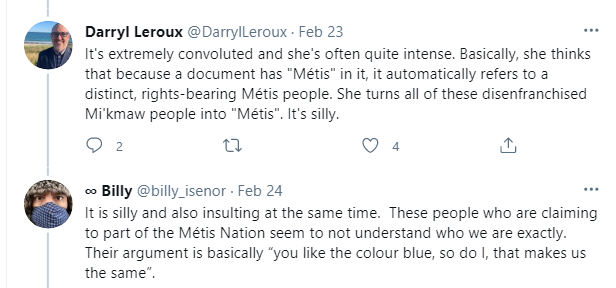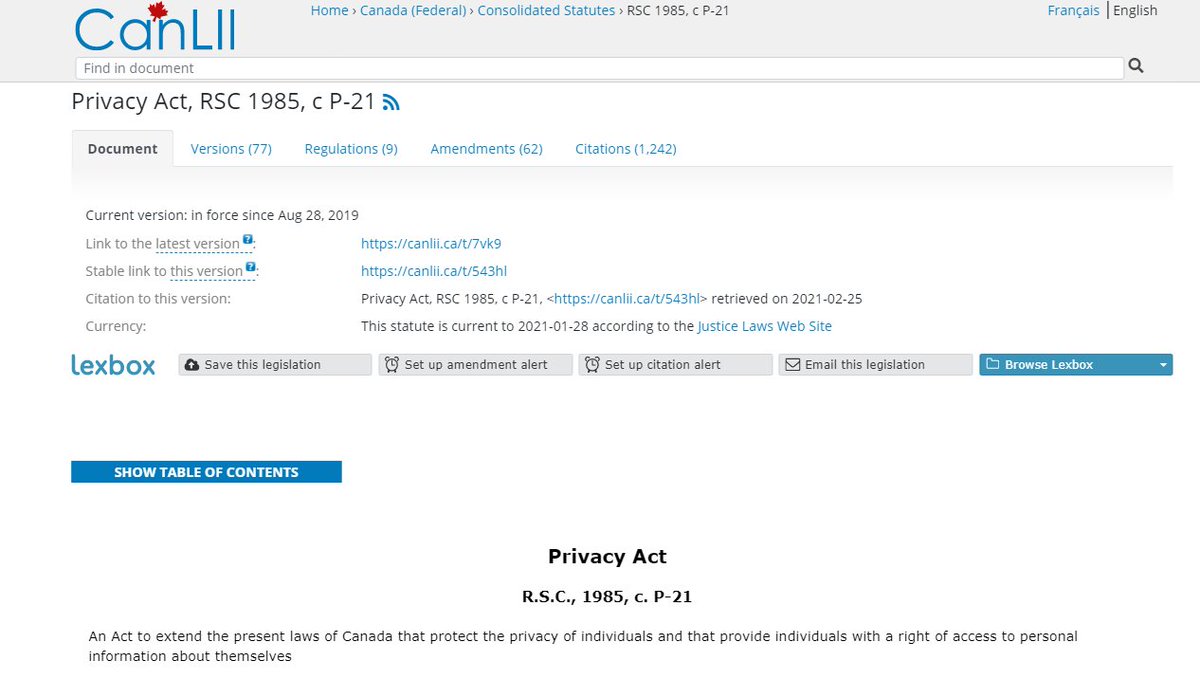
We are Metis - the ethnography of a halfbreed community in northern Alberta-by Driben, Paul-1985- some trace their origin as far back as two hundred and fifty years, to the early days of French rule in Canada. 

We are Metis - the ethnography of a halfbreed community in northern Alberta-by Driben, Paul-1985-legally established definition of a Metis is clearly non-sexist in appearance, referring only to person of mixed white and Indian blood. pg 61. 

We are Metis - the ethnography of a halfbreed community in northern Alberta-by Driben, Paul-1985- If a man marries or enters into a common law relationship with a non-metis women she can live on a colony so long as her husband meets the legal requirements. She becomes a bona 



fide settler because of her husband, Metis by association. This explains why there are women at East Prairie who trace their descent directly from Indian and Euro-Canadian fathers. They are wives or common-law partners of a man who are officially approved members. (Me - so once
again you do not need to be Indigenous to be Metis) We are Metis - the ethnography of a halfbreed community in northern Alberta-by Driben, Paul-1985- Riel was captured, tried and hung for treason. With the failure of of this second attempt to establish a Metis Nation in the west. 

Many of Riel's followers were forced to move again. / In effect, this meant that the Metis were a political autonomous unit. While HBC did attempt to keep up the appearance of rule this proved to be an impossible task. George Simpson,in 1856 servant of the company writes 

the following memo- The HBC's rights are treated by the ... Half-breeds as fictions of law...which we cannot and dare not attempt to enforce, and in our present position this is correct.
We are Metis - the ethnography of a halfbreed community in northern Alberta-by Driben, Paul-1985- The Red River Settlement - emerged as an agricultural colony, manned by British settlers. (Red River Experiment) 

We are Metis - the ethnography of a halfbreed community in northern Alberta-by Driben, Paul-1985- Metis population growth coincided with the growth of the Western Canadian fur trade. As HBCs and NWC traders moved towards the west, and married or established free unions with 

Indian women, the metis population grew. They were literally the offspring of the fur trade and were found where ever trading posts were located. From these posts, the Metis continued to move west, always in accord with their role as middlement in the trade. It was a direct
result of geographic expansion of the fur trade that the first group of Metis arrived in the Lesser Slave Lake area.
We are Metis - the ethnography of a halfbreed community in northern Alberta-by Driben, Paul-1985- Some native and aborignal groups have been ignored. Metis - the half-breed population of Canada, the descendants of mixed Indian and European ancestors, Like other halfbreeds, they 

have been regarded as neither fish nor fowl, neither white, nor black, not red, nor brown - Berry 1963:29 - They have been ignored.
We are Metis - the ethnography of a halfbreed community in northern Alberta-by Driben, Paul-1985- Hrdlick, who made a study of 696 Ojibwe Indians at the White Earth Reservation in Minnesota, and found that a large proportion of the tribe was ..mixed with whites in all possible 

grades... Stewart concludes that the Metis were historically and now Ojibwe Indians - (1960:351)
We are Metis - the ethnography of a halfbreed community in northern Alberta-by Driben, Paul-1985- Omer Stewart has taken the visibility argument one step further, in a short article written in 1960, he notes that the Metis of the nineteenth century were of mixed Ojibwa and 

Caucasion biological stock, but that they should be considered Ojibwa Indians because they participated in the 𝗴𝗿𝗲𝗮𝘁 𝗣𝗹𝗮𝗶𝗻𝘀 𝗢𝗷𝗶𝗯𝘄𝗮 𝗯𝘂𝗳𝗳𝗮𝗹𝗼 𝗵𝘂𝗻𝘁𝘀 & 𝗺𝗼𝘀𝘁 𝗼𝗳 𝘁𝗵𝗲 𝗵𝗮𝗹𝗳𝗯𝗿𝗲𝗲𝗱𝘀 𝘀𝗽𝗼𝗸𝗲 𝘁𝗵𝗲 𝗢𝗷𝗶𝗯𝘄𝗮 𝗜𝗻𝗱𝗶𝗮𝗻 𝗹𝗮𝗻𝗴𝘂𝗮𝗴𝗲.
We are Metis - the ethnography of a halfbreed community in northern Alberta-by Driben, Paul-1985- The halfbreed population of Canada now includes some 250,000 individuals scattered across 10 provinces and the Northwest and Yukon Territories (Canada, Department of the Secretary 

of State 1967:237) According to Slobodin (1966:14), the Metis can also be divided into two distinct sub-groups. These are: (a) The Red River Metis whose cultural heritage dates back to the time of Louis Riel and rise of the la nation metisse on the western plains and (b) the
Northern Metis, a small and more recent population native to the northern region of the Mackenzie District.
• • •
Missing some Tweet in this thread? You can try to
force a refresh


















